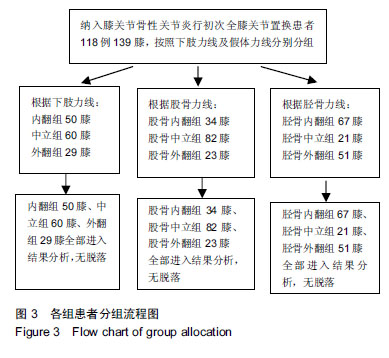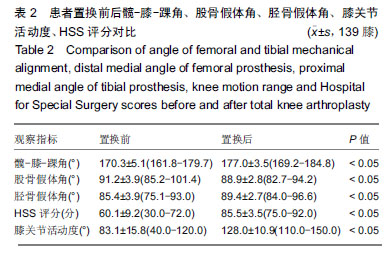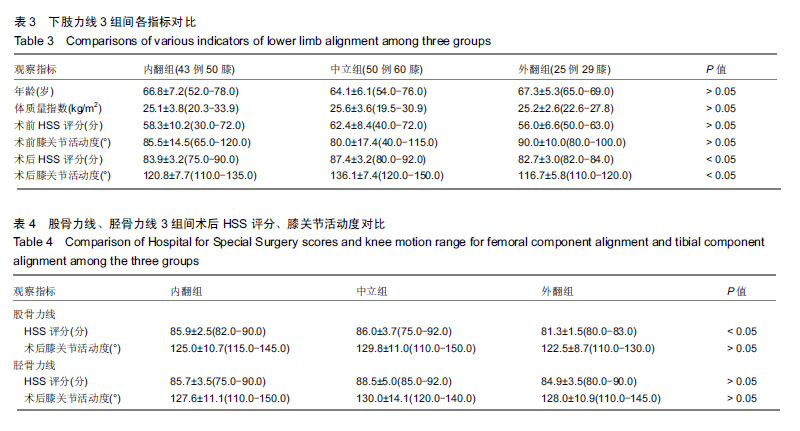| [1]吕厚山. 人工膝关节置换术的进展和现状[J]. 中华外科杂志, 2004, 42(1):30-33.[2]Ritter MA, Davis KE, Meding JB, et al. The effect of alignment and bmi on failure of total knee replacement. J Bone Joint Surg Am. 2011;93(17):1588-1596.[3]Hungerford DS. Alignment in total knee replacement. Instr Course Lect. 1995;44:455-68. [4]Sharkey PF, Hozack WJ, Rothman RH, et al. Insall Award paper. Why are total knee arthroplasties failing today? Clin Orthop Relat Res. 2002;404(404):7-13.[5]Bellemans J, Colyn W, Vandenneucker H, et al. The chitranjan ranawat award: is neutral mechanical alignment normal for all patients?: the concept of constitutional varus. Clin Orthop Relat Res. 2012;470(1):45.[6]Vanlommel L, Vanlommel J, Claes S, et al. Slight undercorrection following total knee arthroplasty results in superior clinical outcomes in varus knees. Knee Sur Sports Traumatol Arthrosc. 2013;21(10): 2325-2330. [7]Ritter MA, Faris PM, Keating EM, et al. Postoperative alignment of total knee replacement. Its effect on survival. Clin Orthop Relat Res. 1994;299(299):153.[8]Parratte S, Pagnano MW, Trousdale RT, et al. Effect of postoperative mechanical axis alignment on the fifteen-year survival of modern, cemented total knee replacements. J Bone Joint Surg Am. 2010;92(12):2143.[9]Howell SM, Kuznik K, Hull ML, et al. Results of an initial experience with custom-fit positioning total knee arthroplasty in a series of 48 patients. Orthopedics. 2008;31(9):857-863.[10]Howell SM, Hodapp EE, Vernace JV, et al. Are undesirable contact kinematics minimized after kinematically aligned total knee arthroplasty? An intersurgeon analysis of consecutive patients. Knee Surg Sports Traumatol Arthrosc. 2013; 21(10):2281-2287.[11]Ramadier JO, Buard JE, Lortatjacob A, et al. Radiological assessment of knee deformity in the frontal plane (author's transl). Rev Chir Orthop Reparatrice Appar Mot. 1982;68(1):75-78.[12]Ewald FC. The Knee Society total knee arthroplasty roentgenographic evaluation and scoring system. Clin Orthop Relat Res. 1989;248(248):9-12.[13]Longstaff LM, Sloan K, Stamp N, et al. Good alignment after total knee arthroplasty leads to faster rehabilitation and better function. J Arthroplasty. 2009;24(4):570-578.[14]Puliero B, Favreau H, Eichler D, et al. Total knee arthroplasty in patients with varus deformities greater than ten degrees: survival analysis at a mean ten year follow-up. Int Orthop. 2019;43(2):333-341. [15]Matziolis G, Adam J, Perka C. Varus malalignment has no influence on clinical outcome in midterm follow-up after total knee replacement. Arch Orthop Trauma Surg. 2010;130(12):1487-1491.[16]Magnussen RA, Weppe F, Demey G, et al. Residual varus alignment does not compromise results of tkas in patients with preoperative varus. Clin Orthop Relat Res. 2011;469(12): 3443-3450.[17]Shetty GM, Mullaji A, Bhayde S, et al. Factors contributing to inherent varus alignment of lower limb in normal Asian adults: role of tibial plateau inclination. Knee. 2014;21(2):544-548.[18]Delport H, Labey L, Innocenti B, et al. Restoration of constitutional alignment in TKA leads to more physiological strains in the collateral ligaments. Knee Surg Sports Traumatol Arthrosc. 2015; 23(8):2159-2169.[19]Slevin O, Amsler F, Hirschmann MT. No correlation between coronal alignment of total knee arthroplasty and clinical outcomes: a prospective clinical study using 3D-CT. Knee Surg Sports Traumatol Arthrosc. 2016;25(12):1-9.[20]Fang DM , Ritter MA , Davis KE. Coronal alignment in total knee arthroplasty: just how important is it? J Arthroplasty. 2009; 24(6-supp-S):39-43.[21]Saragaglia D, Sigwalt L, Refaie R, et al. Influence of the post-operative axis on the clinical results of total knee replacement for severe varus deformities: does a slight residual varus improve the results? Int Orthop. 2018. doi: 10.1007/s00264-018-4092-7.[22]Huang TW, Lee CY, Lin SJ, et al. The influence of alignment on midterm outcome after total knee arthroplasty in patients with marked coronal femoral bowing. J Arthroplasty. 2015;30(9): 1531-1536.[23]Konan S, Howell S, Oussedik S. Alignment Targets in Total Knee Arthroplasty//Total Knee Arthroplasty. 2015.[24]Saragaglia D, Sigwalt L, Gaillot J, et al. Results with eight and a half years average follow-up on two hundred and eight e-Motion FP® knee prostheses, fitted using computer navigation for knee osteoarthritis in patients with over ten degrees genu varum. Int Orthop. 2018;42(4):799-804.[25]Vandekerckhove PJ, Lanting B, Bellemans J, et al. The current role of coronal plane alignment in Total Knee Arthroplasty in a preoperative varus aligned population: an evidence based review. Acta Orthopaedica Belgica. 2016;82(1):129.[26]Abdel MP, Ollivier M, Parratte S, et al. Effect of postoperative mechanical axis alignment on survival and functional outcomes of modern total knee arthroplasties with cement. J Bone Joint Surg. 2018; 100(6):472-478.[27]Kim YH, Park JW, Kim JS, et al. The relationship between the survival of total knee arthroplasty and postoperative coronal, sagittal and rotational alignment of knee prosthesis. Int Orthop. 2014;38(2):379-385.[28]Gromov K, Korchi M, Thomsen MG, et al. What is the optimal alignment of the tibial and femoral components in knee arthroplasty? Acta Orthopaedica.2014; 85(5):480-487.[29]Howell SM, Papadopoulos S, Kuznik K, et al. Does varus alignment adversely affect implant survival and function six years after kinematically aligned total knee arthroplasty? Int Orthop. 2015; 39(11):2117-2124.[30]Ishikawa M, Kuriyama S, Ito H, et al. Kinematic alignment produces near-normal knee motion but increases contact stress after total knee arthroplasty: A case study on a single implant design. Knee. 2015;22(3):206-212. |
.jpg)



.jpg)
.jpg)
.jpg)